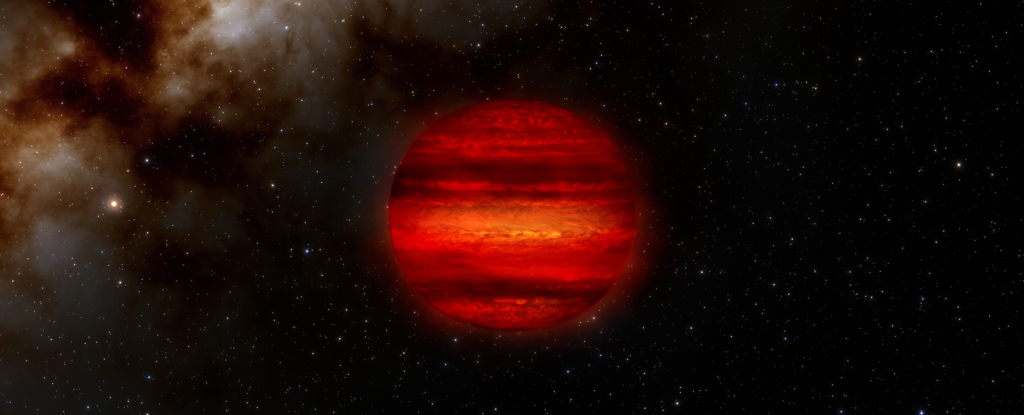We’ve identified the coldest radio-emitting star ever found — a brown dwarf that’s too small to be a normal star and too massive to be a planet.
Our results, released today [July 13] in the Astrophysical Journal Lettersdetails the detection of the pulsed radio emission from this star, designated WISE J0623.
Although it’s about the same size as JupiterThis dwarf star has a magnetic field much stronger than that of our sun. He joins the ranks of a small handful of well-known ultra-cool midgets who generate repetitive bursts of radio.
Make waves with radio stars
With over 100 billion stars in our Milky Way, you might be surprised that astronomers have detected radio waves from fewer than 1,000 of them. One reason is that radio waves and optical light are produced by different physical processes.
Unlike thermal (heat) radiation emanating from a star’s hot outer layer, radio emission is the result of particles called electrons accelerating and interacting with magnetized gas around the star.
Because of this, we can use radio emission to learn more about the atmospheres and magnetic fields of stars, which could ultimately tell us more about the survivability of life on all of the planets that orbit them.
Another factor is the sensitivity of radio telescopes, which historically could only detect very bright sources.
Most star detections with radio telescopes in recent decades have been outbursts from highly active stars or energetic outbursts from interacting binary systems. But with the improved sensitivity and coverage of new radio telescopes, we can see less luminous stars like Cool brown dwarves.
WISE J0623 has a temperature of around 700 Kelvin. That equates to 420°C (788°F), or about the same temperature as a commercial pizza oven — pretty hot by human standards, but pretty cold for a star.
These cool brown dwarfs cannot sustain the atmospheric activity that creates radio emissions in hotter stars, making it harder for radio astronomers to find stars like WISE J0623.
How did we find the coolest radio star?
This is where the new is born Australian SKA Pathfinder The radio telescope comes into play. Located at Inyarrimanha Ilgari Bundara, the CSIRO Murchison radio astronomy observatory in Western Australia, it has an array of 36 antennas, each 12 meters in diameter.
The telescope can see large regions of the sky in a single observation and has already measured almost 90 percent of them. In this survey, we identified almost three million radio sources, most of them active galactic nuclei – black holes in the centers of distant galaxies.
So how can we tell which of these millions of sources are radio stars? One way is to look for something called “circularly polarized radio emission.”
Like other electromagnetic radiation, radio waves vibrate as they travel through space. Circular polarization occurs when the electric field of the wave rotates in a spiral or corkscrew pattern as it propagates.
For our search we took advantage of the fact that the only astronomical objects known to emit a significant proportion of circularly polarized light are stars and stars pulsars (rotating neutron stars).
By selecting only strongly circularly polarized radio sources an earlier study of the sky, we found WISE J0623. Using the slider in the image above, you can see that after switching to polarized light, only one object is visible.
What does this discovery mean?
Was this star’s radio emission a rare, one-off event that occurred during our 15-minute observation? Or could we rediscover it?
previous research showed that the radio emissions detected by other cool brown dwarfs were linked to their magnetic fields and generally repeated at the same rate as the star rotated.
To investigate this, we conducted follow-up observations using CSIROs Australian telescope compact array and with that seaCAT Telescope of the South African Radio Astronomy Observatory.
These new observations showed that there were two bright, circularly polarized outbursts from WISE J0623 every 1.9 hours, followed by a half-hour delay before the next pair of outbursts.
WISE J0623 is the coolest brown dwarf discovered via radio waves and the first case of sustained radio pulsations. Using the same search method, we assume that future investigations will discover even cooler brown dwarfs.
Studying these missing dwarf stars will help improve our understanding of stellar evolution and the evolution of giant exoplanets (planets in other solar systems).
We recognize the Wajarri Yamatji as traditional owners of the Murchison Radio-astronomy Observatory site where the Australian SKA Pathfinder is located, and the Gomeroi people as traditional owners of the Australian Telescope Compact Array site.
Kovi RosePhD student in astrophysics, University of Sydney And Tara MurphyProfessor, University of Sydney
This article was republished by The conversation under a Creative Commons license. read this original article.





